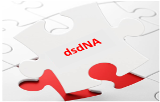Molecular weight markers for double-stranded DNA (dsDNA) are essential for determining the size of DNA molecules in gel electrophoresis. These markers, also known as DNA ladders, consist of a set of DNA fragments of known sizes that serve as standards against which unknown DNA samples can be compared.
Key Characteristics and Types
Key characteristics and types of dsDNA molecular weight markers include:
- Size Range: dsDNA markers are available in various size ranges, from as low as 10 bp up to 48.5 kb or even over 1000 kb for specialized applications like Pulsed-Field Gel Electrophoresis (PFGE). Common ranges include 50 to 1500 bp, 25 to 700 bp, 100 to 1000 bp, and 500 bp to 10 kb.
- Format: Many dsDNA markers are supplied in a ready-to-load format, meaning they are premixed with loading dye, allowing for direct application to electrophoresis gels. Others are provided without pre-mixed loading dye, but often include a separate vial of dye for convenience.
- Reference Bands: Some markers feature specific fragments with double the material content or increased intensity (e.g., 400 bp, 500 bp) to act as easily identifiable reference points on the gel, simplifying size determination.
- Composition: These markers are typically composed of linear, chromatography-purified individual DNA fragments.
- Applications: They are primarily used for sizing double-stranded DNA fragments generated from various molecular biology techniques, such as restriction digests, PCR amplification, and general DNA analysis on agarose and polyacrylamide gels.
- Specificity: It is crucial to use the appropriate nucleic acid ladder (DNA vs. RNA) because RNA migrates faster through electrophoresis gels than DNA.



